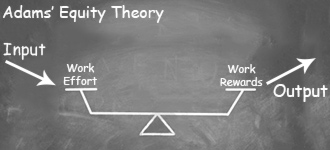

Thus, groups will evolve such systems of equity, and will attempt to induce members to accept and adhere to these systems. A) Individuals can maximize collective rewards by evolving accepted systems for equitably apportioning resources among members.Individuals will try to maximize their outcomes.Outcomes can be both tangible and intangible. When the ratio of inputs to outcomes is close, then the employee should be very satisfied with their job. Outcomes are defined as the positive and negative consequences that an individual perceives a participant has incurred as a consequence of his/her relationship with another. Individual traits such as boorishness and cruelty are seen as liabilities entitling the possessor to costs. The inputs that a participant contributes to a relationship can be either assets (entitling him/her to rewards) or liabilities (entitling him/her to costs). Inputs are defined as each participant’s contributions to the relational exchange and are viewed as entitling him/her to rewards or costs. However, if the first employee perceived the other employee being given more responsibility and therefore relatively more work along with the salary increase, then the first employee may evaluate the change, conclude that there was no loss in equality status, and not resist the change.Īn individual will consider that he is treated fairly if he perceives the ratio of his inputs to his outcomes to be equivalent to those around him.įormula expressing equal equity theory: Ratio of one individual’s outputs to inputs is perceived as equal to that of another individual in comparison. equity theory: an attempt to explain relational satisfaction in terms of perceptions of fair or unfair distributions of resources within interpersonal relationshipsĮquity theory was first developed in 1963 by John Stacey Adams, a workplace and behavioral psychologist, who asserted that employees seek to maintain equity between the inputs that they bring to a job and the outcomes that they receive from it, against the perceived inputs and outcomes of others.įor example, if an employee was given a salary increase but a peer was given a larger salary increase for the same amount of work, the first employee would evaluate this change, perceive an inequality, and be distressed.ratio: The relative magnitudes of two quantities (usually expressed as a quotient).Examples include praise, bonuses, and promotions. outcomes: The positive and negative consequences that an individual perceives to be a result of his/her actions.Examples include time, effort, and loyalty.

Inputs: Each participant’s contributions that are viewed as entitling him/her to rewards or costs.– Much theory related to Equity Theory has been conducted in laboratories and not real world settings.– Some say the model is too simple there are other variables that affect people’s perceptions of fairness which vary from person to person.– An overcompensated employee may adjust their efforts, or may inflate the value of their inputs in their mind, adopting a sense of superiority and thus decrease their efforts.– Employees may adjust outcomes according to purchasing power and local market conditions.– The value of inputs and outcomes will vary from person to person.(3) Distressed employees attempt to fix an inequitable situation by distorting inputs and outcomes in their own minds, by actually changing inputs/outcomes, or by leaving the organization.(2) Employees can and do determine what an equitable return should be by comparing themselves to coworkers.(1) Employees except a fair return for their contribution.(4) Those in distress will attempt to eliminate the inequity, in order to eliminate the distress.Those who get too little feel angry/humiliated, while those with too much feel guilt or shame. (3) Individuals in an inequitable relationship feel ‘distressed’.Groups will reward those who treat others equitably, and punish those who don’t.(2) Groups will evolve systems of equity, and induce members to adhere to these systems.(1) Individuals try to maximize outcomes.The person who gets too little may feel angry or humiliated. The person who gets too much may feel guilt or shame. According to equity theory, the person who gets “too much” and the person who gets “too little” both feel distressed.Outcomes, on the other hand, include salary, benefits, job security, reputation, sense of achievement, gratitude, etc. Inputs include effort, time, loyalty, seniority, commitment, personal sacrifice, etc.Equity theory was developed in 1963 by John Stacey Adams, who stated that an employee will consider himself to be fairly treated if the ratio of his inputs to outcomes is equivalent to those around him (by his perception).


 0 kommentar(er)
0 kommentar(er)
